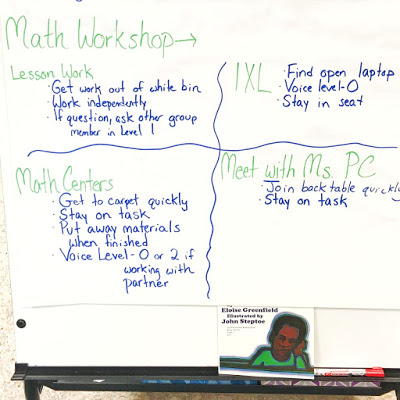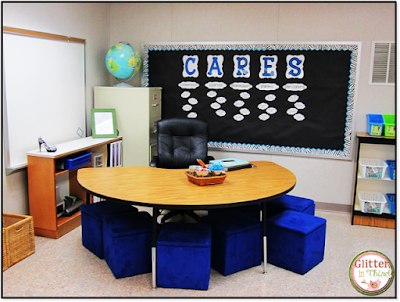Join the VIP Teacher Club!
Do you like teaching math? I used to struggle with teaching math until I began doing stations in my classroom. I find whole-group math frustrating for all learners- high and low! I am fanatic for stations and small groups in my classroom. Whole group, although it definitely has its place in the classroom, tends to result in my highest ability students being bored and antsy, while my lower students struggle to keep up and feel uncomfortable. Stations and small groups allows for easy differentiation for students, and allows students to work in a setting with similar abilities and learning styles.
Now, please note that this is how I like to do math stations. Is this the only way? Nope! Is this the best way? Oh my goodness, no! All of us strive for our kids to be the best mathematicians that they can be, but this happens in a variety of ways and teaching styles. There are as many variations of math stations as fish in the sea (well…. maybe not that many). I’m sharing with you how I like to teach math. I hope that you find some value or interest in this post, but you may find that none of it works for you- and that is okay!
My math stations were originally inspired by 3rd-Grade Thoughts, so some of my wording will sound similar (such as Lesson Work for independent work).
THE STATIONS
I discuss each station in depth below. However, my math stations consist of four total:
 The most important thing before starting anything in the classroom is to discuss procedures and expectations. Before we start doing rotations, the students and I have a discussion about how the routine will work. We create this chart together as a group for each of the centers.
The most important thing before starting anything in the classroom is to discuss procedures and expectations. Before we start doing rotations, the students and I have a discussion about how the routine will work. We create this chart together as a group for each of the centers.
As you can see in the anchor chart to the right, we discuss voice level, and what to do if they have questions or finish early. This anchor chart is a great place for them to keep coming back to if they are unsure what is expected of them, I love how I can quickly see it and remember to say things like “Hearts, you’re on IXL but your voice level is at a 2.” It makes it easy for a common ground and expectation. Visuals make all the difference with students, and having a place to reference what is expected of each of us is key.
My classroom assistant (which changes weekly) is in charge of the magnets. This is a routine that needs to be practiced so that students understand which way to move the magnets when they hear the chime. Every time that I ring the chime, the classroom assistant quickly changes the magnets. Math is over when I have met with each group, or each group has made a full rotation.
WHAT IS EACH STATION?
Math centers
For my math centers, I always have something that is hands-on, whether an activity that uses a math manipulative or a game. For example, for place value I found a fantastic resource from Teachers Pay Teachers called Roll it! Make it! Expand it! Before stations, we go over what materials that students will need when they are doing math centers. All the kids need are dice and a dry-erase marker. When it is their turn to do a math station, they walk to the rug, grab a dry-erase marker, sock eraser, pair of dice, and get to work!
If you’re interested, I offer a growing third-grade math center bundle in my TPT store!
Lesson work
Lesson work is the concrete component of a math worksheet or handout. I know worksheets are used less often nowadays in the classroom, but I firmly believe that they are an important piece of a math period in moderation. Combined with hands-on math centers and technology, they are definitely a helpful way to ensure that students understand a concept.
Lesson work is usually review of what we were doing the day before, or a spiral from something we learned earlier in the year. I do not like to give out new topics for lesson work, because my students sometimes really struggle with a new topic. Since I do not want to be disturbed when working with a small group, I do not want them sitting around doing nothing and being confused. Spiraling back allows them to reinforce and strengthen older concepts that they previously learned.
I leave the lesson work next to my projector in the front of the room. When students get on this station, they pick up a handout and get to work. Their voice level is a 0. If they need help, they can whisper to a group member for help. When finished, they highlight their name and put into the Inbox!
Technology
For technology, I either assign an IXL standard or assign a few pages from one of my Google Drive math resources.
My school pays for IXL, a wonderful math website that gives each student a username and password. There is accountability for their work, since teachers can log on and see each student’s progress, strengths, and weaknesses. Students also LOVE it since it lets them get a chance to get onto the laptops and iPad! I leave a list of usernames and passwords in the basket in case kids forget what theirs are. I usually select standards from IXL that we are currently studying, although closer to testing in the spring I spiral back with topics that are more difficult for the kiddos. If your school has PTA money, I strongly suggest purchasing IXL. Students can use it at home, and it has made a tremendous impact on the mathematically ability of my students.
Teacher time

Teacher time means that students get to come and meet with me at my table! Students come over quickly and quietly. I already have pencils for the kids. Sometimes I ask them to bring over their math interactive notebook if we are going to work on them. This station is the most important one to me, because I get to work with students in very small groups. I can quickly assess them, and differentiate their learning. I always do a quick mini-lesson with each group. The reason I like to do it with each group instead of the whole class is that it helps students focus, and is a more encouraging environment for students to ask questions. A small group also gives me the ability to offer enrichment, remediation, and quickly assess students on their learning.
How does math look in your classroom? Do you use stations or small groups?

Hey there, I’m Kelly! I I love helping teachers save time with technology and resources so they have more hours in the day to spend with family and friends. Take a look around to find new ideas that you can implement in your classroom today!
2 Responses
Oooh! I love that you are a Responsive Classroom teacher too! 🙂 I noticed your CARES in the background while I was checking out math stuff!
YES! I love Responsive Classroom, glad to meet another RC teacher 🙂